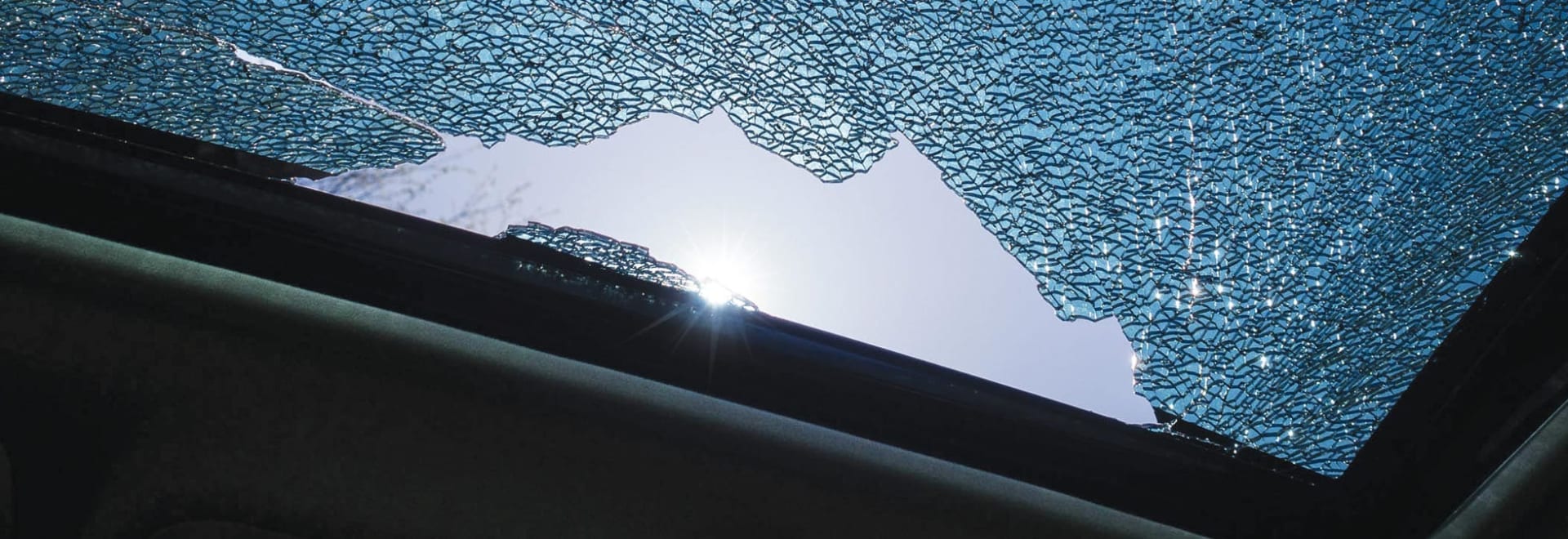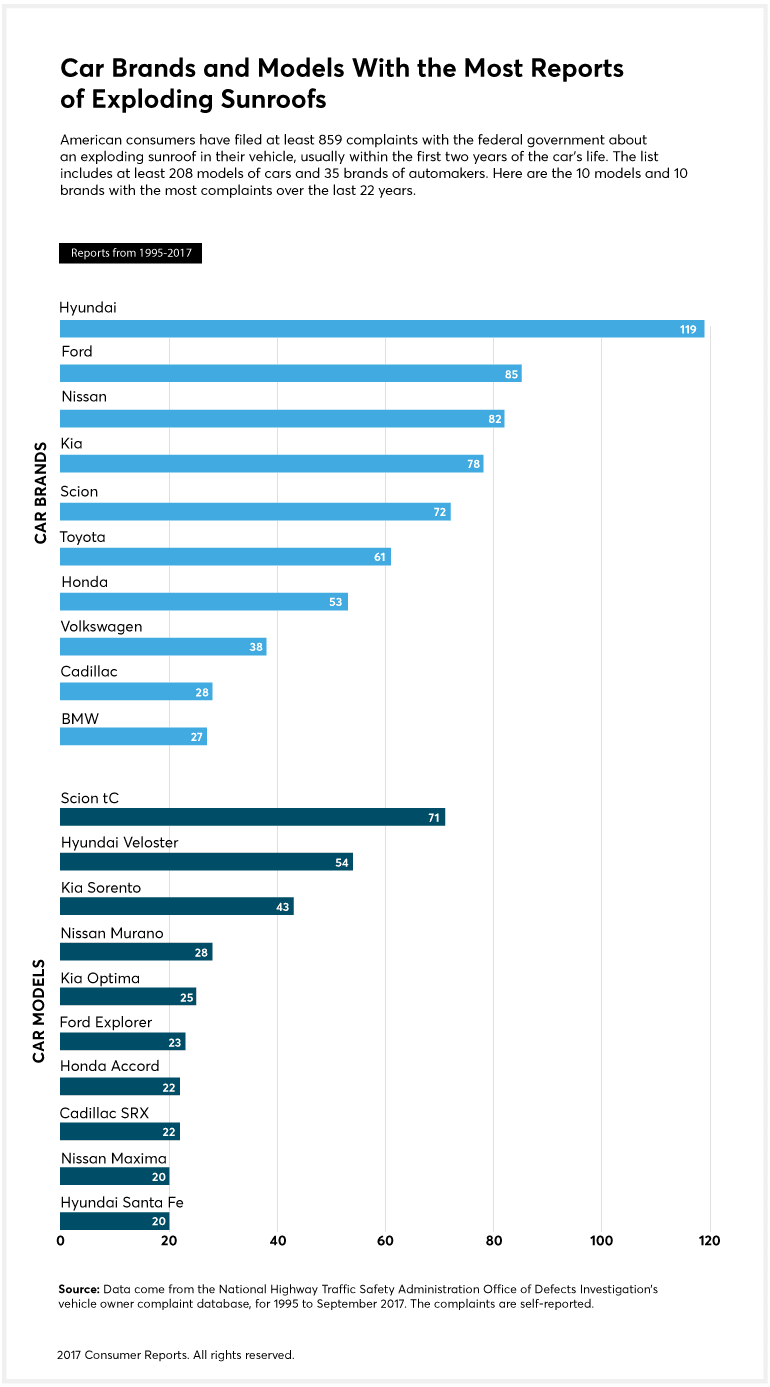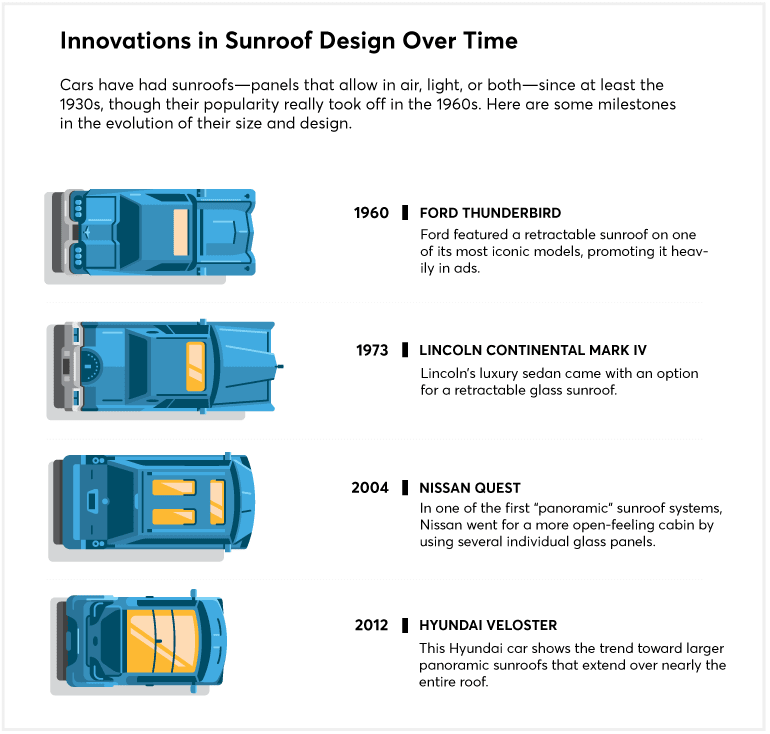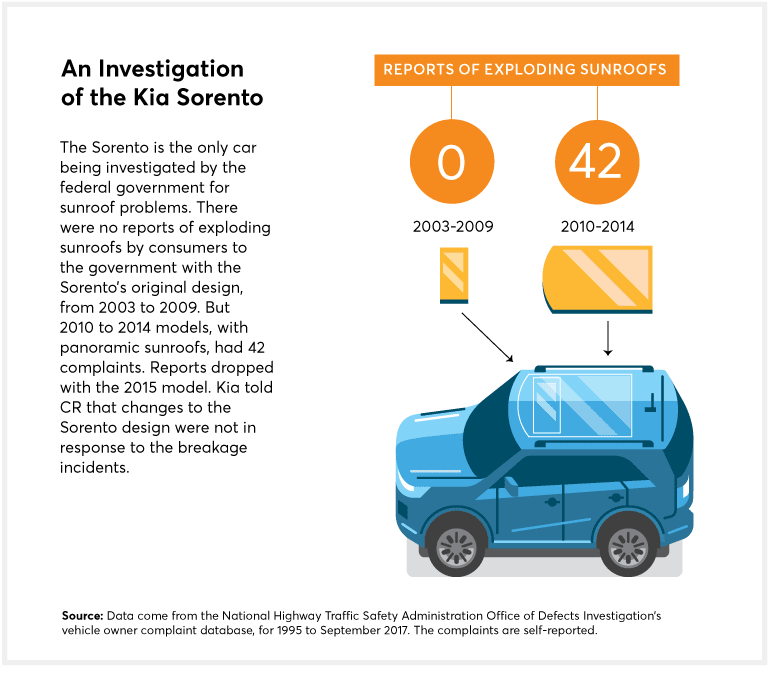 Image courtesy of DAVID WUJCIK
Image courtesy of DAVID WUJCIK
Exploding Sunroofs: Danger Overhead
Consumer complaints about exploding sunroofs have spiked in recent years. How to stay safe and avoid large repair bills
When it happened, Heather Savage had two of her five children with her in their 2016 Nissan Pathfinder. Four-year-old Eli was strapped into a car seat in the second row, and Raquel, 15, whom they’d just picked up from ballet class, was in the front passenger seat.
They were on their regular route home, in Cache Valley, Utah, going about 40 mph, when Savage heard a loud, powerful explosion. “My heart was racing,” she says. “It’s not something you expect to happen when you’re driving.”
She suspected a tire had blown, but the SUV wasn’t wobbly. When she could, she pulled over and got out to look around, at first thinking, “Hmm, my tires are fine.” Then she looked up and saw that the sunroof had exploded, dropping hundreds of bits of glass onto the sunroof’s shade guard, above her children’s heads.
“I feel really lucky that I had that shut at the time,” Savage says. “When I was looking at cars, I loved the sunroof, but I never imagined in a million years that would happen.”
An exploding sunroof might sound like a freak occurrence, but a Consumer Reports investigation has found that it’s not. These incidents have happened in every month of the year in every part of the country, in vehicles from all over the world; they have occurred on interstates, on country roads, and even while parked in driveways.
Sunroofs have significantly expanded in size in recent years, and they’ve also grown in popularity. And the number of consumer complaints about them shattering without warning has soared.
While this doesn’t happen nearly as often as, say, a tire blowout on the highway, any explosion while driving can present a real safety hazard.
And although the issue is well known to the auto industry and government safety regulators, drivers generally assume that their sunroofs are safe.
Our investigation has found that, with a few exceptions, automakers are not acknowledging or resolving the issue. It’s also clear that the safety standards and regulatory oversight of sunroofs have not kept pace with those dramatic size and design changes and that more needs to be done to guarantee they are safe.
While experts we interviewed don’t necessarily agree on what is causing the explosions of glass, they align on this: The bigger the expanse of glass, the harder to ensure that it won’t shatter.
The odds of this happening to you are low, but when a vehicle’s sunroof does shatter, consumers are often left on their own to deal with it. CR found that there is little consistency in how dealerships or automakers acknowledge or resolve this safety and repair issue, or about who should pay. (Do you own a car with a panoramic sunroof, or are you thinking of buying one? Read our advice on how to protect yourself, both financially and physically.)
Shattered sunroofs have been reported in at least 208 models of vehicles representing 35 brands over the last 20-plus years in the U.S., based on CR’s analysis of the consumer complaints database maintained by the National Highway Traffic Safety Administration.
Since 1995, American vehicle owners have gone to the trouble of filing at least 859 official accounts with the safety agency, with 71 percent of those incidents occurring since 2011. CR has read through those reports, and while some details vary, they’re identical to Heather Savage’s experience in this way: A sunroof suddenly shatters with no direct or known cause.
Among the complaints, there are at least 36 reports of injuries, mainly minor cuts or scrapes, but no serious injuries or deaths.
“A shower of glass fell on me,” the owner of a 2013 Hyundai Veloster said in his complaint to NHTSA. “I managed to get to work with a bloody arm and forehead, and thank God I had no other cars close to me when it happened.”
Some automakers—Hyundai, Ford, Nissan, Kia, and Toyota, for example—are more represented among the NHTSA complaints. The Scion tC, Hyundai Veloster, Kia Sorento, Nissan Murano, and Kia Optima were the most-cited models. The Sorento is the only car currently under investigation by NHTSA.
CR’s analysis of the available government and industry sunroof failure data suggests that the problem is spread across the industry but is more prevalent in some brands—notably Kia and Hyundai—than their overall market share would indicate.
“When you have evidence of a problem like this, regardless of what the standards say, automakers should develop a better approach,” says David Friedman, who served as NHTSA’s acting administrator in 2014 and is now director of cars and product policy and analysis at Consumers Union, the policy and mobilization division of Consumer Reports. “They don’t need to wait for NHTSA to prod them.”
Consumer Reports would like to see several things happen:
• Any automaker with a pattern of shattering incidents should order a recall if it hasn’t already.
• Regulators should expand their investigation of the Sorento to include other automakers and models. There is enough evidence to consider this a safety defect, Friedman says, and NHTSA should not wait for serious injuries to act.
• The auto industry as a whole needs to establish stronger safety standards for so-called panoramic sunroofs without waiting for regulators.
For this special report, we talked with owners who experienced these explosions and with automakers, regulators, glass and structural engineers, and industry and safety experts. We also reviewed federal defect investigations, industry technical bulletins, class-action lawsuits, and U.S. and international reports on sunroof explosions.
An Underreported Issue
Read through the consumer accounts in the NHTSA database and some stand out. A limo company from Long Island, N.Y., for example, told NHTSA in August of 2014 that it had suffered five sunroof explosions—all within its 18-vehicle fleet of 2014 Lincoln MKTs, made by Ford. One was parked in the company’s lot when it exploded.
A 2012 Kia Optima owner wrote, “Either I was struck by a meteorite or Kia has defective glass.” The driver, from Houston, reported minor glass cuts. (NHTSA redacts names in the self-reported complaints.)
For consumers, the pain comes in waves, first when they have to live through the experience, and then when negotiating repairs and determining who pays. A Marion, Ark., man with an exploded sunroof on his 2013 Ford F-150 pickup truck wrote, “Ford customer service denied my warranty claim, so I had to get it repaired under my insurance and pay the difference,” which, he said, came to $1,009.68.
What’s clear is that the consumer complaints in NHTSA’s database are only a fraction of the actual sunroof explosions occurring in the U.S.
While owners of Kia Sorentos have filed at least 43 reports of shattered sunroofs with U.S. regulators, Kia has told NHTSA it has at least 156 Sorento sunroof cases in its own records. Kia Optima owners have filed at least 25 reports with regulators, but the company told NHTSA it is aware of 173 shattered Optima sunroofs.
Ford reported 88 sunroof explosions for its Edge crossover vehicle—11 times the number of complaints that have been reported to NHTSA.
The safety agency requested automaker data and other information on shattering sunroofs from 13 manufacturers as part of its defect investigation into the Sorento, but hasn’t publicly shared all of what it learned. Documents from five of the 13 responses are posted on NHTSA’s website, but even among those five, key responses are redacted or missing.
(NHTSA told us that it is working on getting the remaining eight into the public file.)
This lack of transparency on the true extent of this widespread safety issue may be why the problem has yet to fully bubble up into the public consciousness or to attract the serious attention of U.S. regulators. And it may be why consumers seeking remuneration have turned to joining class-action lawsuits brought against individual automakers.
Based on the number of complaints, Jason Levine, executive director at the Center for Auto Safety, says, “Something is going on. Calling it an act of God feels like an old industry playbook for a new car feature. The fact the roof is half glass instead of a quarter glass or no glass doesn’t change the responsibility of the industry and the individual automaker to make sure the compartment is as safe as possible,” he says, adding, “The concern has to be for safety first, and then the aesthetics.”
The international community has been aggressive in trying to solve for this vulnerability—first prompted by South Korean regulators looking into a spate of complaints in 2013 linked to cars from the Korean carmakers Hyundai and Kia, and a few others.
NHTSA has been investigating the Sorento for model years 2011 to 2013 since 2013, yet visible progress appears to have slowed since spring of 2016.
When CR asked NHTSA about the status of the Sorento investigation, the agency said that it “continues to analyze test data and other information to determine if this issue is linked to a defect,” but gave no sense of when the investigation will be completed.
The agency did not specifically address most of the questions we asked, including whether it supports a tougher standard for sunroof glass and if it is concerned about spikes in complaints since 2013.
The popularity and prevalence of supersized sunroofs has mushroomed in the four years that NHTSA has been investigating the Sorento, and in that time, there has also been a marked spike in reported incidents to NHTSA. Starting in 2013, consumer complaints to NHTSA more than doubled from the year before, from 41 to 100, and then nearly doubled again to 187 in 2014.
Features like panoramic sunroofs are often designed into luxury vehicles and then later proliferate to a broader span of vehicles. “They don’t always transfer successfully,” Levine says. “Whenever these sorts of reports crop up across manufacturers and across years, it starts to raise questions about whether there’s been enough preparation for the expansion” of these types of features.
In Consumer Reports’ last three Annual Auto Surveys, at least 35 people identified an exploding sunroof as a serious problem with their vehicle.
Melody Terai, a 2011 Kia Sportage owner from British Columbia, Canada, was one of them, telling CR her sunroof exploded as she merged onto the highway. Terai says she is still anxious about it: “Hopefully, amongst all the other recall issues, this one will be addressed before [a] death” happens.
Is Bigger More Dangerous?
Panoramic sunroofs are an impressive feat of engineering—a large pane of glass curved to the roof’s aerodynamic contours and usually made of tempered glass, for its strength without added weight.
There’s a seductive quality about them, perhaps because they connect people to the outdoors in the same way skylights do in homes.
And automakers have figured out that consumers will part with thousands of dollars for luxury packages that feature one. Some brands—including Hyundai and Kia—have made them available in almost every model. As a result, panoramic sunroofs have become both mainstream and larger, sometimes covering nearly the entire roof.
But there’s no reason sunroofs can’t be big, spectacular—and safe. Auto-glass experts and structural engineers CR spoke with say there are ways to make sunroofs safer, beginning with the kind of glass they’re made of.
In their investigation, South Korean car safety regulators found that a step in the manufacturing process known as “ceramic printing”—used to coat some of the glass, creating a darker area that hides mechanical parts—can make portions of the pane weaker and more vulnerable to shattering.
After investigating certain car models, South Korean safety officials asked a United Nations body in charge of global transport regulations to look at developing new standards for glass.
U.S. regulators are cooperating with their counterparts in the U.N.’s Working Group on Panoramic Sunroofs. If the U.N. group, which has been meeting for two years, comes up with a tougher global standard, the U.S. could follow its lead.
In 2011, NHTSA toughened standards to prevent occupants from being ejected through side windows during a rollover but chose not to issue a similar requirement for sunroofs. Research shows that using laminated glass—two panes fused by a sheet of plastic and designed to hold its form even when shattered—could reduce ejections in other parts of the car.
NHTSA told CR that the agency is researching “the structural integrity of sunroofs in a variety of circumstances, including reducing passenger ejection.”
Industry sources mentioned that Ford had begun using laminated glass for sunroofs in some of its models. When asked about it, the company said: “Ford uses both laminated and tempered glass in vehicle applications depending on the engineering requirements.”
Meanwhile, Volvo told us it has patented a design for laminating sunroof glass, “providing superior protection in rollover situations.”
The Automakers’ Response
In all, Consumer Reports reached out to 17 automakers to find out, among other things, how often they’ve heard from their customers about exploding sunroofs, whether they’ve detected any telling patterns, and if they would support a standard of glass that would make shatterings less likely.
While all companies acknowledged receipt of our questions, nearly all of their responses were short on specifics, with some companies citing pending lawsuits as a reason for not being more forthcoming.
Fiat Chrysler told us that “safety is paramount” and that it continually monitors “the performance of our vehicles in the field.” Many of the other automaker responses echoed that theme.
When asked about its sunroofs, Kia mostly blamed road debris: “When a cause of breakage is identifiable, it is always road debris or projectiles, even in cases involving users who insist no road debris caused the breakage.”
Blaming the Driver
Omid Rashid, a chemical engineer from Alberta, Canada, was driving his 2015 Toyota Venza last winter on a sunny, 40° F day.
Rashid had noticed some popping sounds coming from the roof, but he didn’t know what to make of them. Then he heard a sound “like a bomb,” and suddenly he was showered in glass.
Shaken, and far from home on a remote highway, with ears still ringing, he waited hours for a tow truck to take him to the nearest Toyota dealer. He recalls going to sleep in a hotel room with glass shards still in his hair.
The next day, he says, a dealership technician said it was pretty common and likely caused by a rock, a theory Rashid says was also repeated by a Toyota corporate representative.
Rashid wasn’t buying it.
He’d been expecting some sympathy or an apology. Instead, he got a repair bill of roughly $900 and, to his engineer’s mind, at least, lots of faulty reasoning.
Rashid says he knew the temperature didn’t fluctuate much that day (CR confirmed), and no other vehicles were nearby. And he says any rock spit out from his own car’s tires would have flown backward, not up toward the roof. “The laws of physics say this is not possible,” Rashid says.
Toyota said that while it could not comment on this specific incident, it “is committed to the safety and security” of its customers.
“There is no doubt in my mind, this is a safety defect,” Rashid says. “I could have hit another car, I could have hit another obstacle. Thank God, there was nothing around me.”
Searching for a Cause
While there is much debate over the prevailing cause for sunroof explosions, there is generally agreement on this: Current regulatory standards haven’t kept pace with the size or design innovations in panoramic sunroofs. Basically, this means that some sunroofs are underengineered.
Glass in cars must meet minimum standards drawn up by the American National Standards Institute and SAE International, the society of automotive engineers. But those provisions haven’t been revised since 1996—long before supersized sunroofs became mainstream.
Tempered glass is nearly always used in sunroofs because it meets the existing standard. It’s the same kind of glass used in side and rear windows and is generally strong. Tempered glass, experts say, is sufficient when sunroofs are small and flat but not for those that are large and curved.
One problem is that modern designs are more three-dimensional and often involve bending glass to the curvature of the roof, notes Rob Vandal, senior director of research and development with Guardian Glass, a major American automotive glass supplier. That makes them more susceptible to impacts, even from very small objects, Vandal says, because they present a more vertical surface for an offending object to strike.
“Statistically, it’s going to be subject to some failure, and the failure will be a catastrophic fall-in,” Vandal explains.
Russ Corsi, who worked nearly 32 years for Pittsburgh-based PPG, a global supplier of auto glass, says larger sunroofs are also more prone to weakening over time as the pane absorbs impacts from bumps in the road, twists and turns of the car’s frame, and “thermal shock”—the expanding and contracting from sudden temperature changes.
If sunroofs are “just breaking [on their own],” Corsi says, “it’s likely to be a manufacturing flaw,” noting “the larger the piece of glass, the smaller the margin of error.”
For example, Corsi says one quality-control issue involves the beveled edge that surrounds the perimeter of roof glass. A chip at that edge can make the glass vulnerable to failure, which, with tempered glass, means an explosion.
Corsi says one way to prevent exploding sunroofs might be to use a hybrid glass that has characteristics of both tempered and laminated glass.
Further complicating the safety equation are the pressures every automaker feels to reduce costs and to keep vehicles lighter for better gas mileage. Automakers generally use the thinnest glass they can—about half a centimeter thick.
Instead of calling for a specific type of glass, regulators could add performance requirements that windshields already must withstand.
A Range of Remedies
All of this makes it nearly impossible to differentiate a stable sunroof from a vulnerable one. People might presume there are adequate safety standards for such a prominent feature as a panoramic sunroof. Consumers must rely on a manufacturer’s quality control and regulatory diligence.
NHTSA can investigate and order recalls. Aside from its current investigation into the Sorento, the agency has conducted four previous sunroof-defect investigations since 2004. Two resulted in automaker recalls while the models were under NHTSA investigation—for the 2012 Hyundai Veloster and the 2004 Nissan Maxima. Two others closed with no defect identified—the 2004 - 2006 Cadillac SRX and the 2005 - 2006 Scion tC. Those two models are among the top 10 in consumer complaints.
Audi and Volkswagen have issued sunroof recalls without NHTSA first opening an investigation, Audi for its 2012 Q5 and the 2013 - 2014 A8 and S8, and Volkswagen for its 2013 - 2015 Beetle. A spokesman for both brands told CR, “We take the safety of our products seriously.”
Other, less transparent approaches are available to automakers, like “technical service bulletins” sent to dealers. Bulletins typically tell dealers how to fix a known problem, but only after a consumer complains. Bulletins aren’t an admission of a safety defect, and repairs aren’t necessarily free. Hyundai, Kia, Mitsubishi, and Toyota have dealt with various sunroof fixes, including leaks, in this way.
Consumer Reports has identified about a dozen class-action lawsuits in the U.S. involving shattered sunroofs, finding complaints against Hyundai, Kia, Ford, Mercedes-Benz, Nissan, and Volkswagen, among others. Generally, these suits assert that automakers are failing to protect car owners, knowingly selling vehicles with safety defects, and not honoring warranties.
Brian Kabateck is an attorney for a Lexus owner in a case against Toyota. All his client is asking, he says, is that the manufacturer does right by its customers. “Just extend the warranty,” he says. “It’s not like we’re trying to make a bazillion dollars.”
In response to a suit Hyundai is facing, the company asserted last December that there aren’t any problems or defect with its sunroofs, and denies it failed to warn drivers about any “alleged” danger.
When asked to explain the recent decline in Veloster shattering incidents, Hyundai told CR its recall had solved the original problem. The company’s investigation blamed the high number of incidents on a malfunctioning “unloading station robot” that could have damaged the glass during the manufacturing process.
Picking Up the Pieces
Heather Savage says her husband, Roy, made it his job to figure out a fix for the year-old vehicle. He started with the Nissan dealership. “I told them that the sunroof just exploded, and they’re like, ‘Well, you should be fine to drive it. But it’s nothing we do; we don’t fix it.’ ”
With five kids and a busy life, he didn’t take time to argue, but contacted his insurer, who told him to use a glass servicer. With glass coverage, their portion of the $1,005 bill was a $100 deductible.
Next, he searched the internet for answers: “I was a little miffed,” he says, and disappointed “that sunroofs don’t have a protective membrane making them like windshields.”
Nissan told CR it has no evidence of a sunroof issue with its cars and suggests consumers should submit claims to their insurance company.
Since her episode, Heather Savage says she can’t stop worrying about all the glass overhead. The sunroof shade guard remains permanently on duty, she says.
“I’m really hesitant to open it, or to go to a car wash, or do anything that might potentially break it,” she says. “It’s kind of scary.”
Want more consumer news? Visit our parent organization, Consumer Reports, for the latest on scams, recalls, and other consumer issues.






